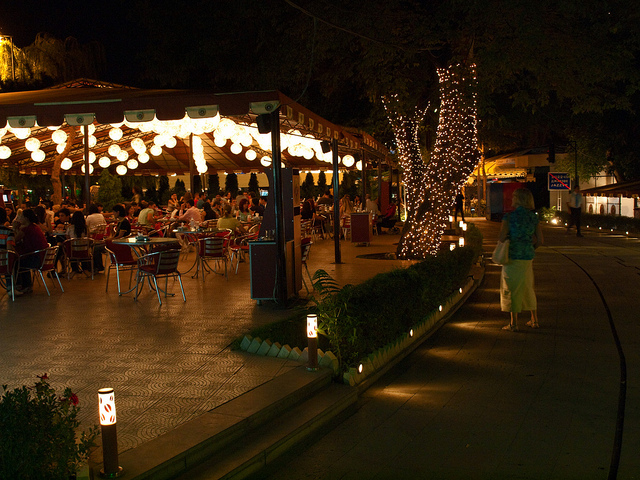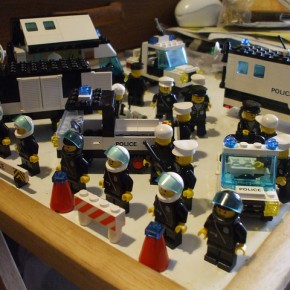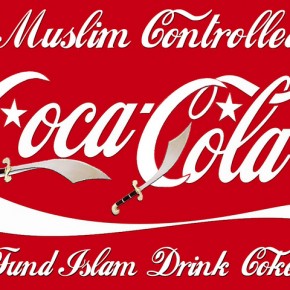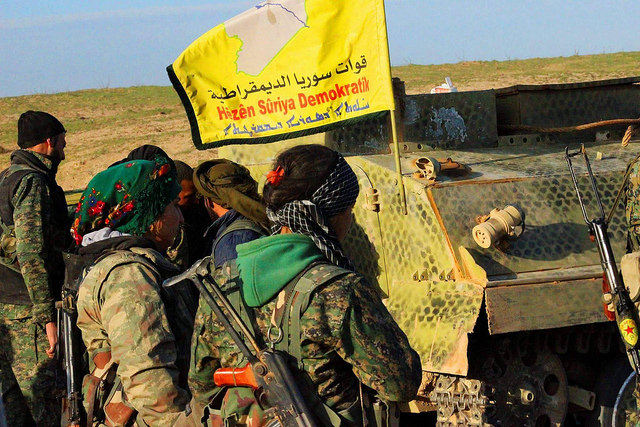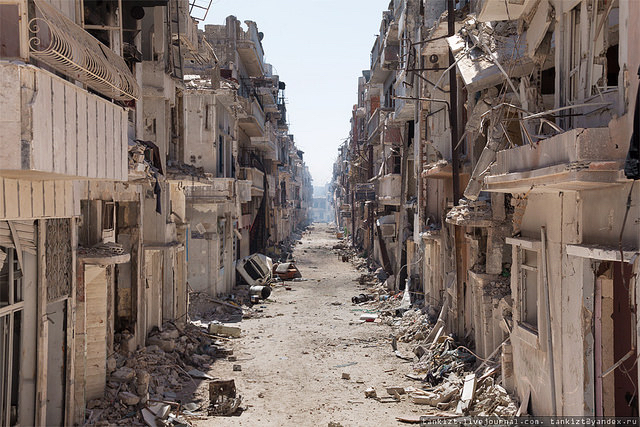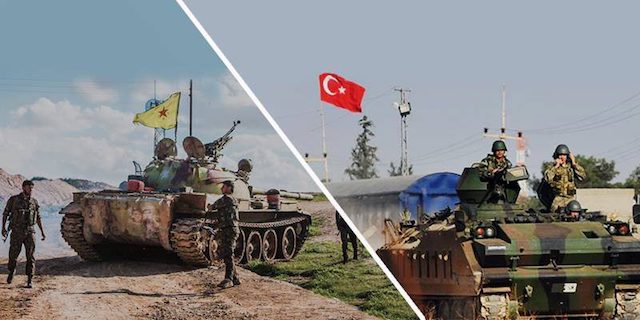“So how are you leaving Armenia?” Levon asked, with a smile. After six months in Yerevan, I was soon to return home. I regretted my decision. Levon, the composite character of Syrian-Armenian refugee and kebab stall owner I had come to know during my stay, was arranging triangular Khachapuri, Georgian cheese pastries, on a baking tray. When tessellated, he grinned at his handywork, then up at me.
We must have spent hours like this since my arrival in Yerevan, at this small window of light in the corrugated plastic cubicle on a side street in the Armenian capital. He would churn the night air with conspiracies and rumour: small talk for the hard times. I changed his name, age, and moustache, and shared some of his monologues in Café Aleppo and Café Aleppo Revisited.
Yerevan had thawed a little since our last discussion, as had its inhabitants. A kind of spring had just arrived, and Mother Armenia (hammered copper, 1962) above the city centre watched the scene with mute indifference. From a distance, through the fog, her silhouette resembled a cross – which may have been the intention all along.
I shook dozens of hands across Yerevan that day in farewell, and a compatriot, a Syrian-Armenian taxi driver from Aleppo, had reminded me again of Levon. The ride was sour laughs and silence. For a few minutes, I labored under the pretense that I could empathize with him, a few nods and cues here and there.
After a few minutes I begin to rue the thought, sitting there mute, deciphering street signs as they flash past. “In Syria I had a beautiful car,” said Aram, caressing the steering wheel. “Beautiful. I couldn’t afford spare parts for it, but it was beautiful even when broken.”
“Now,” he spat, “I drive a bloody Lada.” His hands clenching the wheel, digging his fingernails into the old rubber. He hated this bloody Lada, and he hoped to join his son in America.
“There is nothing to do here.” Turning onto Khanjyan Street, the gold cross hanging from the mirror swung wildly. “I am a spare part.”
I was leaving Armenia, I told Levon. First to Georgia, to Tbilisi, and then flying back to the UK. Had he been to Georgia? He most decidedly had not.
“I can’t go there. I have a mosque complex.” I asked Levon to elaborate, which he would have done anyway. We would be here a while.

“My friends tell me there are mosques in Georgia. After everything… I can’t stand them, I can’t stand the sound of them, I can’t stand the azan [call to prayer]. That’s my mosque complex.”
Most Muslims in Georgia, I pointed out, were ethnic Azeris. “What is the difference?” he asked, rhetorically. “You know, there are Mujahedeen from Azerbaijan in Syria – killing Armenians. There are Mujahedeen from Chechnya out there, killing Christians – they call themselves Muslim, but they don’t speak one word of Arabic.”
Suddenly, I find myself in front of Levon’s baking tray. He had finished rescuing some egg-shaped, vegetable-filled pastries from boiling oil and assorted them lovingly on a tray. It would be Easter soon (“Armenians are the first Christians.”) I bit into one. My palate could make out chickpeas and hummus. If I’d known the dish’s name, I’ve already forgotten it – and Armenian friends I’ve asked are equally clueless.
Hummus, added Levon with relish, is after all a Christian invention (whatever the Israelis may believe). How could it be anything but?
“The Arab, he came from the desert. The Turk, he came from Central Asia, a nomad – and what do they have? Yoghurt? Milk? Some cheese, perhaps?”
A group of drunks passed by along the darkening street, with soggy, alcoholic voices. Levon muttered some obscenities and leaned toward me, conspiratorially.
“Do you know what Anatolia, Ana dolu means?” I hadn’t a clue, but I was probably going to find out. “It means a woman with large breasts. Ana means mother in Turkish”. He glanced back at his wife, chopping tomatoes, and back at me. “The Turk (always just the one) – the real Turk – looks like he’s Chinese.”
“Like this.” Levon uses his two fingers to squeeze his eyelids back. I feel uncomfortable. He laughs. “But when the Turk arrived, he married the local women – and now a Turk, well, he could look just like me!”
That, of course, was an absurdity. He furrowed his brow and plunged his fingers into greying hair, as if to illustrate the point. Anatolia had many children, Levon believed – and all of them were illegitimate.
“I have a friend, an Armenian friend, whose surname is Zeytun-oğlu, a Turkish surname! He ought to be Mr. Zeytunyan. Zeytunyan.” He shrugs, stares blankly, and then cups his face in his hands, nursing a full stop. Kill us, he seemed to say, but at least leave us the dignity of our names.

I fished around for a thousand drams and finished the egg (on the house), smiling sheepishly and muttering a few platitudes I forgot to jot down. Not my corner of the globe, I try and remain neutral, and so forth. My job wasn’t to have opinions about such matters. At least, not yet.
When I told him I had met several Iranians, Levon found the notion comical. According to him, any Iranian who would befriend a foreigner – not to mention a Western European – was being deceitful. Iranians, after all, are Muslims. And Muslims cannot not abide Europeans.
“And what about the Tatars in the Crimea?” I prompted. They could be considered pro-European, at least by virtue of being anti-Russian.
“How can a Tatar love Europe?’ he asked, by way of reply. ‘He’s pro… Tataristan, Tataria. Or Turkey. Or Mongolia…”
I thought of the time I had spent in Tatarstan, but only smiled gently.
At the time of writing, the Armenian populated town of Kassab in North-Western Syria, near the border with Turkey’s Hatay Province, had come under heavy attack. As part of the Alawite-populated Latakia Governate, and a potential opening to the Mediterranean for the Syrian opposition, the area is strategically important – and fighting in Kassab has led Armenians to flee.
While Armenian President Serzh Sargsyan thanked the Syrian government for its efforts to protect the Armenian minority, he did not directly address accusations of Turkey’s involvement in the attack. Much ink has already been used in speculation over the town’s fate. With only one year left before the centenary of the Armenian genocide, and some claims of actual Turkish military involvement, the fear (and hyperbole) is understandable. After all, this is Armenia’s ancient Kingdom of Cilicia. It sits across the border from an ominous place in Hatay – Musa Dagh, the site of resistance against the Armenian genocide, and setting of Franz Werfel’s 1933 novel.
History has not been kind to the Armenians, and neither, I at times believe, has Armenia itself. I recall a conversation (which soon became an argument) with a repatriated Armenian in Yerevan. Syrian-Armenian refugees have been resettled by the Armenian government in the depopulated and disputed Kashatagh region of the unrecognized Republic of Nagorno-Karabakh.
Many of them are from Qamishli in northeastern Syria. They are farmers, and therefore (so the reasoning goes) suited to their new villager lives in Karabakh. I was contemptuous. How could the Armenian government be so cynical as to resettle refugees from a current war zone into a potential one?
“Cynical, perhaps’, noted my friend, “but Karabakh is not at war yet. The key word is potential.”
Levon was an Aleppine; the city life suited him. One day, he promised, I would see these places for myself, and feast on Za’atar, as his guest at home in Syria.
“‘I will miss you,” said Levon. “Whenever you come back, I am sure we will meet again. I will be right here.”
I wrote down his words and smiled, as we disappeared into the night.
Photographs courtesy of Shaun Dunphy, the author, and Tommy and Georgie. Published under a Creative Commons License.
